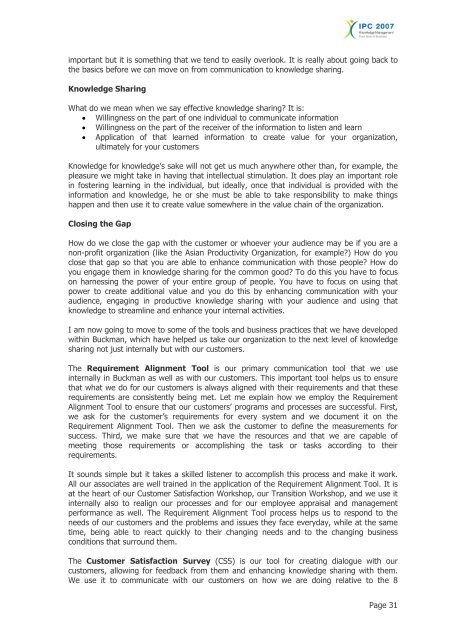Knowledge Management: From Brain to Business (PDF 5.5 - Asian ...
Knowledge Management: From Brain to Business (PDF 5.5 - Asian ...
Knowledge Management: From Brain to Business (PDF 5.5 - Asian ...
You also want an ePaper? Increase the reach of your titles
YUMPU automatically turns print PDFs into web optimized ePapers that Google loves.
important but it is something that we tend <strong>to</strong> easily overlook. It is really about going back <strong>to</strong><br />
the basics before we can move on from communication <strong>to</strong> knowledge sharing.<br />
<strong>Knowledge</strong> Sharing<br />
What do we mean when we say effective knowledge sharing? It is:<br />
• Willingness on the part of one individual <strong>to</strong> communicate information<br />
• Willingness on the part of the receiver of the information <strong>to</strong> listen and learn<br />
• Application of that learned information <strong>to</strong> create value for your organization,<br />
ultimately for your cus<strong>to</strong>mers<br />
<strong>Knowledge</strong> for knowledge’s sake will not get us much anywhere other than, for example, the<br />
pleasure we might take in having that intellectual stimulation. It does play an important role<br />
in fostering learning in the individual, but ideally, once that individual is provided with the<br />
information and knowledge, he or she must be able <strong>to</strong> take responsibility <strong>to</strong> make things<br />
happen and then use it <strong>to</strong> create value somewhere in the value chain of the organization.<br />
Closing the Gap<br />
How do we close the gap with the cus<strong>to</strong>mer or whoever your audience may be if you are a<br />
non-profit organization (like the <strong>Asian</strong> Productivity Organization, for example?) How do you<br />
close that gap so that you are able <strong>to</strong> enhance communication with those people? How do<br />
you engage them in knowledge sharing for the common good? To do this you have <strong>to</strong> focus<br />
on harnessing the power of your entire group of people. You have <strong>to</strong> focus on using that<br />
power <strong>to</strong> create additional value and you do this by enhancing communication with your<br />
audience, engaging in productive knowledge sharing with your audience and using that<br />
knowledge <strong>to</strong> streamline and enhance your internal activities.<br />
I am now going <strong>to</strong> move <strong>to</strong> some of the <strong>to</strong>ols and business practices that we have developed<br />
within Buckman, which have helped us take our organization <strong>to</strong> the next level of knowledge<br />
sharing not just internally but with our cus<strong>to</strong>mers.<br />
The Requirement Alignment Tool is our primary communication <strong>to</strong>ol that we use<br />
internally in Buckman as well as with our cus<strong>to</strong>mers. This important <strong>to</strong>ol helps us <strong>to</strong> ensure<br />
that what we do for our cus<strong>to</strong>mers is always aligned with their requirements and that these<br />
requirements are consistently being met. Let me explain how we employ the Requirement<br />
Alignment Tool <strong>to</strong> ensure that our cus<strong>to</strong>mers’ programs and processes are successful. First,<br />
we ask for the cus<strong>to</strong>mer’s requirements for every system and we document it on the<br />
Requirement Alignment Tool. Then we ask the cus<strong>to</strong>mer <strong>to</strong> define the measurements for<br />
success. Third, we make sure that we have the resources and that we are capable of<br />
meeting those requirements or accomplishing the task or tasks according <strong>to</strong> their<br />
requirements.<br />
It sounds simple but it takes a skilled listener <strong>to</strong> accomplish this process and make it work.<br />
All our associates are well trained in the application of the Requirement Alignment Tool. It is<br />
at the heart of our Cus<strong>to</strong>mer Satisfaction Workshop, our Transition Workshop, and we use it<br />
internally also <strong>to</strong> realign our processes and for our employee appraisal and management<br />
performance as well. The Requirement Alignment Tool process helps us <strong>to</strong> respond <strong>to</strong> the<br />
needs of our cus<strong>to</strong>mers and the problems and issues they face everyday, while at the same<br />
time, being able <strong>to</strong> react quickly <strong>to</strong> their changing needs and <strong>to</strong> the changing business<br />
conditions that surround them.<br />
The Cus<strong>to</strong>mer Satisfaction Survey (CSS) is our <strong>to</strong>ol for creating dialogue with our<br />
cus<strong>to</strong>mers, allowing for feedback from them and enhancing knowledge sharing with them.<br />
We use it <strong>to</strong> communicate with our cus<strong>to</strong>mers on how we are doing relative <strong>to</strong> the 8<br />
Page 31
















